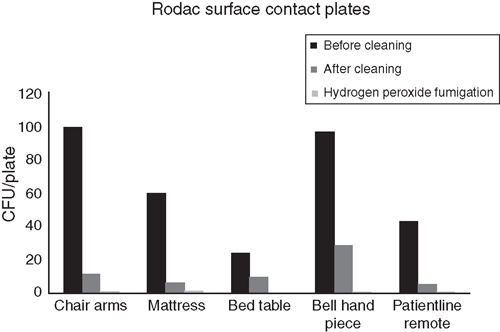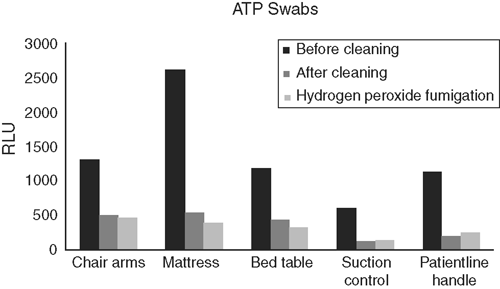Evaluation of cleaning effectiveness in a tertiary hospital following hydrogen peroxide (HPV) fumigation using surface contact plates and adenosine triphosphate (ATP)
Eleni Mavrogiorgou A B , Robert Ayres A , Brian Ward A , Margaret Graham A and Nicholas Brown AA Cambridge University Hospitals NHS Foundation Trust.
B Corresponding author. Email: eleni.mavrogiorgou@nnuh.nhs.uk
Healthcare Infection 18(1) 45-46 https://doi.org/10.1071/HI13009
Submitted: 21 January 2013 Accepted: 22 January 2013 Published: 27 February 2013
The following study was performed at Addenbrooke’s Hospital in Cambridge in the UK and shows the efficacy of using Deprox hydrogen peroxide for decontamination of hospital side rooms, whilst also highlighting the applications and limitations of using ATP for monitoring. Addenbrooke’s Hospital (1100 beds) is part of the Cambridge University Hospitals NHS Foundation Trust and provides specialist services including transplantation, neurosurgery and haematology for the East of England region.
Hospital cleaning in the UK has attracted high media attention and improved standards may have contributed to the recent fall in Clostridium difficile infections and transmission of methicillin-resistant Staphylococcus aureus (MRSA).1 Many Trusts, including St George’s Healthcare NHS Trust and the University of Nottingham NHS Trust, use hydrogen peroxide (HPV) fumigation as part of the cleaning and room decontamination process. Adenosine triphosphate (ATP) bioluminescence is one method used to evaluate the cleaning process.2 ATP has been used in the food industry for many years as a measure of cleaning efficacy and has been advocated as a tool to monitor cleaning standards in hospitals.3
To evaluate the effectiveness of Deprox HPV fumigation in hospital wards, ATP bioluminescence (Clean-Trace, 3M) was used in combination with microbiological methods counting the total viable colony count (TVC) during the calendar year 2010.
The surface cleanliness of five environmental surfaces in 58 hospital rooms was compared before cleaning, after cleaning with chlorine-based products and then after the Deprox HPV fumigation (Hygiene Solutions). Rodac 60 mm plates (surface contact plates containing trypticase soy agar and polysorbate 80 for the detection of microorganisms on non-porous surfaces) were used to determine the TVC on chair arms, the mattress, bed table, call bell and TV console using a standardised method. ATP bioluminescence values were determined in duplicate at the same sites. Hospital rooms and surfaces were cleaned with Chlor-Clean tablets (Guest Medical), containing sodium dichloroisocyanurate instead of hypochlorite, so ATP results should not be affected. Hydrogen peroxide vapour fumigation was conducted using 4.9% hydrogen peroxide (Hygiene Solutions).
Over the course of 12 months 1840 environmental assessments produced data from 58 rooms. The mean TVC value before cleaning was 325 CFU/plate. It was significantly reduced after cleaning to 62 CFU/plate and after Deprox HPV fumigation to 3 CFU/plate (T Test: P < 0.001) (Fig. 1). Mean ATP values (RLU) were 6995 before cleaning, 1831 after cleaning (P < 0.001) and 1598 after HPV fumigation (T Test: P > 0.5) (Fig. 2). Similar findings were seen across each of the 5 sites tested.

|

|
Microbiological methods and ATP bioluminescence both demonstrated the efficacy of routine cleaning. The additional benefit of the Deprox HPV process was shown by lower TVC values but not by ATP. This may be explained by the fact that ATP measures residual organic soil which may include non-viable microorganisms whereas microbiological methods measure viable colonies only. In conclusion, ATP readings provided quantitative evidence of improved cleanliness of high-touch surfaces and in the future can be incorporated more frequently in routine hospital cleaning along stands methods.
Conflict of interest
The authors have no conflicts to declare.
Funding
We would like to thank Hygiene Solutions for funding this project.
Acknowledgements
We would like to acknowledge the assistance of the staff of Cambridge Health Protection Agency Microbiology laboratory and Hygiene Solutions.
References
[1] Dancer SJ. Mopping up hospital infection. J Hosp Infect 1999; 43 85–100.| Mopping up hospital infection.Crossref | GoogleScholarGoogle Scholar | 1:STN:280:DC%2BD3c%2FhslSktg%3D%3D&md5=d9f285b28d5f1d57d25e3a83ae65fb72CAS |
[2] Lewis T, Griffith C, Gallo M, Weinbren M. A modified ATP benchmark for evaluating the cleaning of some hospital environmental surfaces. J Hosp Infect 2008; 69 156–63.
| A modified ATP benchmark for evaluating the cleaning of some hospital environmental surfaces.Crossref | GoogleScholarGoogle Scholar | 1:STN:280:DC%2BD1czjvVKisA%3D%3D&md5=9520ae317a2140f14f299cf163250d01CAS |
[3] Cunningham AE, Rajagopal R, Lauer J, Allwood P. Assessment of hygienic quality of surfaces in retail food service establishments based on microbial counts and real-time detection of ATP. J Food Prot 2011; 74 686–90.
| Assessment of hygienic quality of surfaces in retail food service establishments based on microbial counts and real-time detection of ATP.Crossref | GoogleScholarGoogle Scholar |

